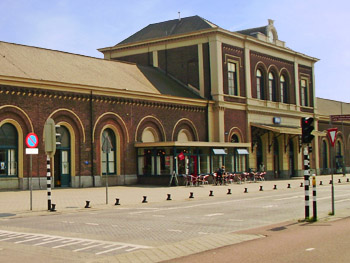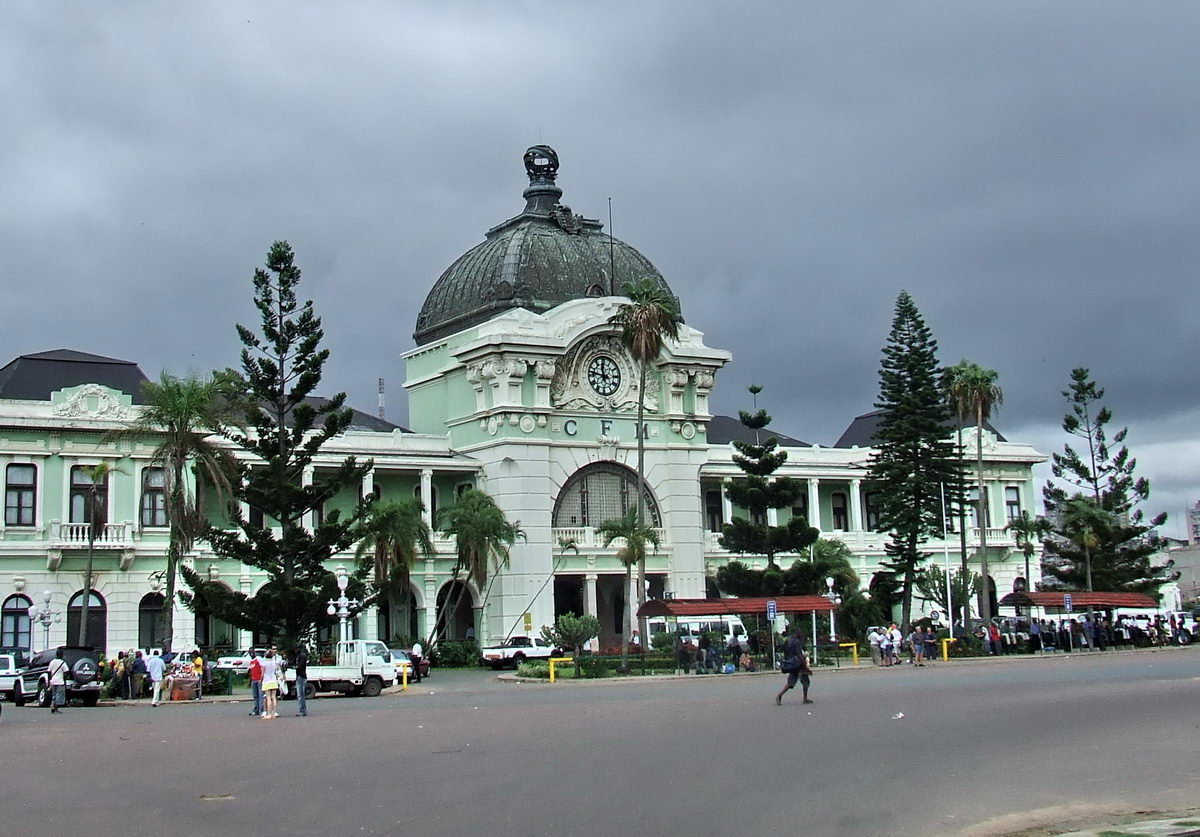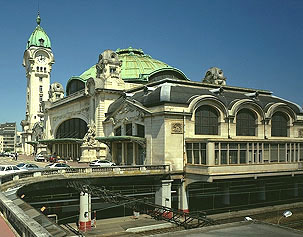Dear readers,
This is our field research project about Middelburg. I hope you enjoy reading it!
Any suggestions and comments are always welcome!
Much Love,
Geert, Fieke, Luuk and Wouter
Did the Roosevelt Academy
influence possible changes in the retail sector around the market square?
Introduction
and Theoretical Framework
 The
Roosevelt Academy was established at the beginning of 2004. At this moment,
eight years after the first students arrived, an average of 600 students are
now inhabitants of Middelburg. These students account approximately for 1.5% of
the total city population. As probably known, students have a reputation for
having strange habits. For some residences it could create irritations; however
others see opportunity in this.
The
Roosevelt Academy was established at the beginning of 2004. At this moment,
eight years after the first students arrived, an average of 600 students are
now inhabitants of Middelburg. These students account approximately for 1.5% of
the total city population. As probably known, students have a reputation for
having strange habits. For some residences it could create irritations; however
others see opportunity in this.
What
our field study will focus on is how the Roosevelt Academy and the students of
the Roosevelt Academy have changed the retail structure in the past eight
years. We will be focusing purely on shops which are within walking distance of
the Roosevelt Academy buildings.
Middelburg
is an interesting city to analyze. When looking at the structure of Middelburg,
the city center is filled with shops, often commonly known chain stores, and
the other parts are filled with restaurants and cafés. Office buildings have
been placed more on the “outskirts” of the city for transportation purposes.
Looking
at it from a social perspective, the yearly seasons and the weather have a
great influence on the amount of people and the type of people in the city.
During the months of June, July and August the city is often a popular
touristic destination for Dutch and German tourists. On the other hand, many of
the students leave Middelburg during these months and return to their
hometowns. Also during the weekend there is a swap of students. Many students
studying in different locations in the Netherlands return to Middelburg, and
the Roosevelt Academy students leave Middelburg and return Sunday evening.
Before
we began our research, we looked at certain sources to see if a possible
prediction could be made. Many sources focused on the student-life in the UK
cities. From these sources we were able to see that in the UK a student city
often dominates a city when the student population accounts for 10 to 15
percent. However, studies have shown that even though a large student city creates
a lot of perspective, many students only make use of the city for entertainment
purposes. However, these entertainment suppliers like pubs and cafes, try to
satisfy the locals as well. Several city centers increase prices during the
weekends in order to give the locals the opportunity to enjoy a drink without
the company of students.
With
the knowledge we have received from our theoretical work, which investigated
different student cities, we predict that the retail structure of the city will
not have changed ever since the Roosevelt Academy was established. The main
argument for our predictions is that we believe that the Roosevelt Academy does
not have enough students, and students seem to spend their extra money for
entertainment purposes rather than new clothing. We do however believe that De
Drvkkery (the bookstore located on the market square) will have benefited,
since students are required to buy books twice a year.
Methods
In
order to answer the main research question ‘Did Roosevelt Academy change the
retailstructure?’ it is necessary to know the retail structure before Roosevelt
Academy was established and the structure now, seven years later. Therefore we
consulted the websites of the land register (Kadaster) and chamber of commerce
(KvK). Moreover, a trip to the municipality of Middelburg was planned to get a
glimpse or a copy of the zoning plan of this moment and of eight years or
longer ago.
However,
the zoning plan only shows if the number of places available in the city for
commercial enterprises has expended/decreased and if so, where in the city. The
map does not reveal which types of shops have expended or become smaller, which
shops are located where and for which reason and what kind of customer base a
shop has and if that has changed. These
questions are important for answering the main question. Thus two additional
research methods are added in order to get an answer on the main question.
For
the interviews, a semi structured interview
was used in order to obtain the data we required. Semi-structured was
chosen because we had a set of research topics and questions in mind, but we
wanted to keep in dynamic if we wanted to improvise. The four questions listed
below were used as a basis for the
interviews.
1)
When is your shop
established?
(Where they here already when RA started?)
2) Why is your shop here? (entrepreneurship -> why interested in
Middelburg? Because of RA?)
3) Has your shop expanded/become smaller since 7 years ago? (Has RA had influence on the shop?)
4)
What is your customer base? Do few/some/many students come here?
The
interview is short because many interviews have to be conducted to get an
overall impression of the influence of Roosevelt Academy
on the retail structure and little time is available. The interviews will be
conducted on shops in close proximity of the market square. Smaller shops are preferred because often the
owner works there him/herself and is able to give the information needed.
History
of the Market Square.
On
the 17th of May 1940, the market square of Middelburg and the surrounding
buildings, including the town hall, were destroyed by a fire that was the
result of a German bombardment. The
reconstruction of the city and the restoring of the buildings started shortly
after the bombardment. Even though the decision was taken to rebuild the city
in the same style, the street pattern of Middelburg’s inner city was slightly
changed: The market square became smaller and some allies were not
rebuilt. As the tramway disappeared from
the market square, another mean of transportation was introduced: the car. For
a couple of years the market square served as a parking facility and only
recently was transformed to a car-free zone.
Zone
planning and the Municipality.
The
zone planning (or City planning) of any
municipality divides up the property into different functions: Some buildings
are meant for residential purposes, others for commercial enterprises, while
thirds can be industrial or public sphere properties. As can be read in Kabir
(2007), City planning is an important and strategic tool in order to facilitate
the needs and wants of the inhabitants of a city. The zone plan of Middelburg
stems from 1992. It is supposed to be remodeled and rethought every 10 years,
but due to unknown circumstances it has been postponed to 2012.
During
the interview with two city hall employees, both of them in the college for
zone planning, it became clear that the plan of 1992 did not changed at all
because of the coming of Roosevelt Academy. They did not foresee a big change
in the dynamics of the city and
calculated that the impact of the Roosevelt Academy would be moderate.
Not even the buildings of Roosevelt Academy needed a change of purpose; the
buildings were categorized in the public
sphere, of which a subpart is educational institutions.
Further
questions revealed that there was an increase in entrepreneurship overall in
the recent years, but no causality could be found in the arrival of Roosevelt
Academy. Also, they explicitly stated that the zone planning might not have changed, but their vision did:
They aim to facilitate student life and student initiative, but this vision is not yet translated into
practical changes for the commercial district or the planning department.
Analysis of the Data:
The
Data from seven shops around the market square
was collected and can be found in the appendix. The basic information
from the four questions can be found there, together with additional
information that occurred from further questioning or extensions given by the
shop owners themselves.
All
the shops were founded before the arrival of Roosevelt Academy, and all of them
had the same reason for being on the market square: or the building was already
in possession of the family business or the building was on a prominent
location with lots of tourists and
shoppers passing by.
There
is a general trend that can be stopped with the answers from the third
question. All interviewed said that they slowly expanded they business the last
decade. But there were also darker tidings; the economic crisis of 2009 can be
felt in every branch of the retail service.
Also the shop owners stated that students did not represent a
significant portion of their revenue.
The
shop owners also stated that students were coming in to their shops once in a
while, but for none the students represented a significant portion of their clientele. The only significant impact students might
have had on revenue, was the amount of students that make use of the
‘Brasserie” the eating café part of De Drvkkery. This was noticed by the
interviewed person there after a while. What was interesting to see, and was
derived from further questioning, is that Roosevelt Academy students might not
have a big impact on local retail, but that the Roosevelt Academy itself does
have a big impact. As the flower shop owner stated, as well as the ‘babbelaars’
store and De Drvkkery. They sometimes receive
an immense order for open days conferences or other important events
Discussion and conclusions
The
conclusions that can be drawn from all the collected data, both municipal and
local, support the thesis that Roosevelt Academy students did not have a
significant impact on the businesses around the market square. This is easily
explainable as the students only number 600 amongst a population of 48,000.
Secondly, the tourism industry is very big in Middelburg, thus even further
decreasing the portion of revenue made by Roosevelt Academy.
A
second point that arose from our
questioning was the impact of Roosevelt Academy as an institute instead of its
members. This point also invites for further researching and discussion. As the
municipal body describes, Roosevelt Academy did not only pull 600 students to
Middelburg, but also created 150 to 200 high quality jobs in Middelburg. Also Roosevelt Academy spends a lot in the
local area, further increasing the revenue of some shops.
As
a general conclusion, the arrival of Roosevelt Academy and its students did not
have an impact on entrepreneurship and businesses in Middelburg in the retail
section. This because students do not have enough money to represent a
significant portion of the revenues made. Even with Roosevelt Academy included
this extra revenue is not enough to stimulate new entrepreneurs for retail
business.
An
extension to the project would be to look for possible influences of the Roosevelt
Academy student population on other
sections of commercial business. An intuitive suggestion would be to look at Roosevelt
Academy expenditure for bars and dance-café’s
in Middelburg. For example, last week a new dance-café opened called
“Bumpers”. To see if the student
population motivated this entrepreneur to begin would be an interesting
extension.
Sources
Chatterton, P. (1999)
University students and city centres - the formation of exclusive geographies -
The case of Bristol, UK. Geoforum 30(2)
Kabir, S., M., H. (2007) Strategic
Planning in Municipal Government: the Case of City of Ottawa.
Canadian social science
Munro, M., Turok, I.
& Livignston, M. (2009) Students in
cities: a preliminary analysis of their patterns and effects. Environment
and Planning 41(8)
Proudfoot, M., J. (1937) City Retail Structure.
Economic Geography, 13(4)
Appendix
Data
Outcome
interviews
Stand:
Flower stand on the edge of the market square (Markt)
Interviewed:
Woman approximately 40 years old and an employee of the stand.
1. 20 years the stand exist.
2. On the market because a lot of people walk by
3. The shop hasn’t expended
but that is because of their license for that exact place on the market.
4. A lot of different people
go to the stand but especially mothers. Sometimes students buy flowers and when
RA hosts a party or an open day they order flowers at the stand.
Shop: (expensive) clothing for men. Peter Christ
(Lange Delft 3)
Interviewed:
a man approximately 30 years old and an employee of the store.
1. The man does not know
exactly but the shop exists longer than ten years.
2. The shop exists in more
places in the Netherlands and is located here because a lot of people come to
the market square.
3. The shop has expended in
the way that it has got more stores through the Netherlands.
4. Sometimes students buy
clothes but not often. When a gala is coming, more students go to the shop.
Shop:
De Drvkkery (Markt 51)
Interviewed:
a woman approximately 60 years old at the information desk of the shop.
1. The woman does not know
exactly but the shop exists longer than ten years at this place.
2. –
3. The shop has expended but
since a year not anymore because of the economic crisis.
4. Many students but they
contribute only for a small bit to the profit made. Students buy especially study
books. The little restaurant within the shop also attracts students and
students are important there to create a ‘young’ atmosphere.
Shop:
Visgilde Middelburg (Markt 39)
1. The shop was established
approximately 30 years ago. The current owner bought the store in April 2011
and continued the existing activities.
2. The location was picked by
the current owner because there was already a similar business based in the
building.
3. As the current owner does
not run his business longer than one year, he could not give a clear overview
of expansion. Yet, he mentioned that there was a noticeable influence of the
current economic crisis.
4. The clientele of the
Visgilde consists mostly of elderly people. Roosevelt Academy students are not
frequent visitors of the business although on Fridays some students buy a
portion of kibbeling.
Shop: FA J.B. Diesch babbelaars (Markt 23)
1. This family business was
established in 1892 on Lange Burg, with its entrance just around the corner of
its current entrance on market square.
2. The location was changed
as a result of the bombardment of Middelburg in 1940 and the shop reopened
shortly after the bombardment on this new location.
3. During the last 7 years,
the shop did not change
4. Once in a while a student
visits the shop but there is no strong influence of students on the sales. The
establishment of RA as a whole does however influence sales as Roosevelt
Academy orders small gifts for guest lecturers and speakers.
Shop:
Linolux (Lange Viele 11-13)
1. The shop opened
approximately 10 years ago on this location.
2. The same business also has
a location on Gravenstraat.
3. –
4. There are not much
students visiting this shop. Only sometimes in the summer a few students buy
products for their rooms when they just moved in.
C.F.Diesch,
Tabacoshop: (Markt 35)
This
shop was founded in 1891 and has been part of the family business for three
generations. The establishment at the Market Square is a privately owned house,
on an attractive location. The shop was always specialized in tobacco, and its
surrounding products. The owner chose to
diversify its products during the last decade, but this summer he has
specialized again in tobacco products. The main argument was that the profit
margin on tobacco was very low, therefore he chose to diversify. Later on,
diversification turned out to be even less profitable, so specialization in
tobacco was once again pursued.
While this trend was in the same period as the arrival of RA and it’s faculty
and students, there was to causal relation between the two. The owner
explicitly stated that students did not visit his shop that often, almost none
at all. The explanation for this was that cigarette products were not sold,
only and strictly tobacco, while students usually small cigarettes. Also RA as
an organization was not involved in any business with the store.






















